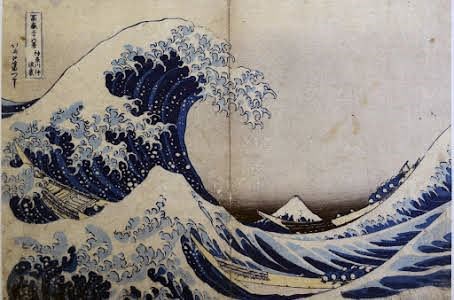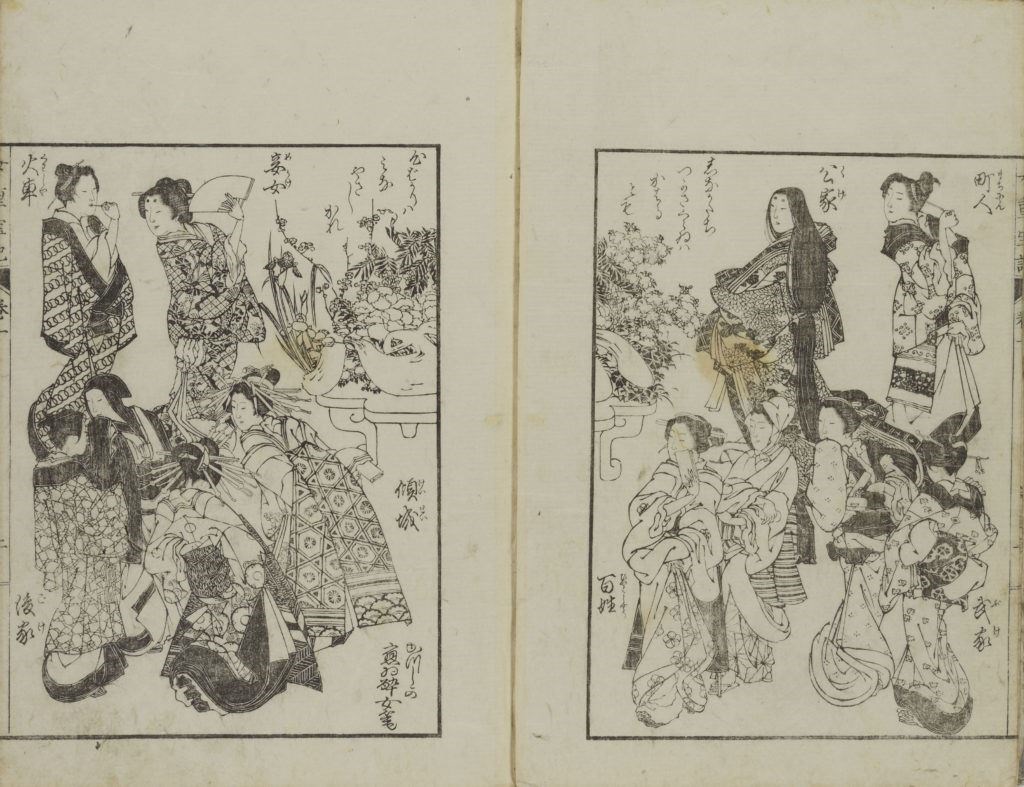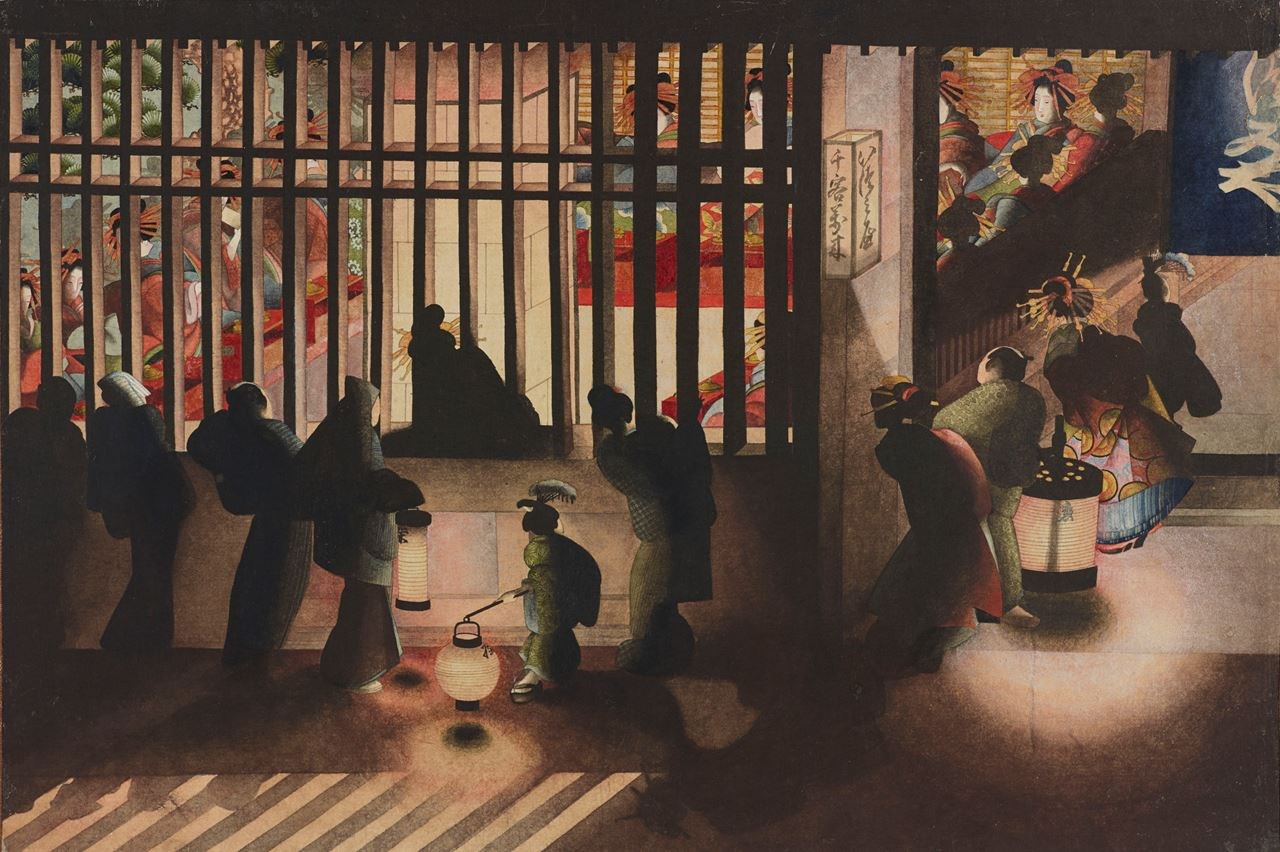This page tells an empowering story of a skillful female artist from late-Edo Japan!
 The Great Wave off Kanagawahttps://g.co/kgs/kAXvES Katsushika Hokusai/ Public Domain via Google Arts and CultureThe famous The Great Wave off Kanagawa from late Edo Japan has inspired lots of artists and producers all over the world, from the day it was produced till today. We can see the motif of the great wave appear not only in artworks but also on cell-phone cases, t-shirts, and other designs of products. This famous wood print was created by an artist called Katsushika Hokusai, probably the most known ukiyo-e artist in his contemporary time. A great artist usually has many assistants and disciples. My hero is one of Hokusai’s assistants, also his third daughter, Katsushika Ōi.
The Great Wave off Kanagawahttps://g.co/kgs/kAXvES Katsushika Hokusai/ Public Domain via Google Arts and CultureThe famous The Great Wave off Kanagawa from late Edo Japan has inspired lots of artists and producers all over the world, from the day it was produced till today. We can see the motif of the great wave appear not only in artworks but also on cell-phone cases, t-shirts, and other designs of products. This famous wood print was created by an artist called Katsushika Hokusai, probably the most known ukiyo-e artist in his contemporary time. A great artist usually has many assistants and disciples. My hero is one of Hokusai’s assistants, also his third daughter, Katsushika Ōi.
Being an artist in Edo-period Japan was not a choice for all women. Women could paint and share thoughts about arts in private gatherings but had no access to art education and further opportunities to become an artist. It was very hard for them to develop their talents in the public realm. Daughters and wives of male artists, however, sometimes had the privilege to advance their talents in a more professional setting and even worked as an artist. Katsushika Ōi was one of these exceptions. Working as her father’s assistant in the workshop, Ōi’s job was to refine details and make additions to Hokusai’s artworks. For instance, an elegant butterfly flying over a bush of blooming flowers, or one of the pictures of a beautiful geisha in a series in Hokusai's work might be actually painted by Oi.
 Treasury of Education for Women https://blog.britishmuseum.org/hokusai-and-oi-keeping-it-in-the-family/ Katsushika Ōi/ Public Domain via The British Museum BlogAlmost all of the Katsushika children had to work in the family workshop. While Ōi’s sisters and brothers were merely performing their duties as a family member, Ōi worked with passion and ambitions. She worked diligently, days and nights in the workshop. And her artist talent was acknowledged by her father: “When it comes to paintings of beautiful women, I can’t compete with her – she’s quite talented and expert in the technical aspects of painting.” Other than helping out with family business, Ōi has her own work circulated on the market as well. Just as her father has pointed out, Ōi was good at painting women. Seeing many ukiyo-e wood prints depicting women under gazes of examination, modeling to be objects of beauty; Ōi’s perspective on female pictures is stunning to me, in a gentle way--no judgements on characters and roles of these females--what she did was simply presenting what she sees in a scene with her remarkable artistic skills. As a viewer, I see a woman’s gist and a free spirit from hundreds years ago.
Treasury of Education for Women https://blog.britishmuseum.org/hokusai-and-oi-keeping-it-in-the-family/ Katsushika Ōi/ Public Domain via The British Museum BlogAlmost all of the Katsushika children had to work in the family workshop. While Ōi’s sisters and brothers were merely performing their duties as a family member, Ōi worked with passion and ambitions. She worked diligently, days and nights in the workshop. And her artist talent was acknowledged by her father: “When it comes to paintings of beautiful women, I can’t compete with her – she’s quite talented and expert in the technical aspects of painting.” Other than helping out with family business, Ōi has her own work circulated on the market as well. Just as her father has pointed out, Ōi was good at painting women. Seeing many ukiyo-e wood prints depicting women under gazes of examination, modeling to be objects of beauty; Ōi’s perspective on female pictures is stunning to me, in a gentle way--no judgements on characters and roles of these females--what she did was simply presenting what she sees in a scene with her remarkable artistic skills. As a viewer, I see a woman’s gist and a free spirit from hundreds years ago.
 Display room in Yoshiwara at Nighthttps://blog.britishmuseum.org/hokusai-and-oi-keeping-it-in-the-family/ Katsushika Ōi Public Domain via The British Museum Here is a picture called Display room in Yoshiwara at Night by Ōi, showing an event from inside and outside of the brothel. We can see skillful manipulation of light and shadow in this picture, a prominent light source from inside the room shines out, partially lighting up the outside space. The shadow of the grid window on the floor contributes to structure the volume of a three-dimensional space. Almost a quarter of the scene is occupied by the ground, creating an angle of viewing from a window a little above the display room shown in the picture. Viewers of the picture are therefore invited to look into the scene, as part of the spectators in the picture. Those lanterns held in spectators’ hands illustrate part of their configurations, making their identity visible; there are all kinds of people viewing into the room from the dark, men, women, and even children, but mostly men. All of these people are appreciating the beauty of women in the room, though being obscure partially by the window, they are truly the protagonist of the scene. Lights and shadow, viewer’s gaze, even the architecture itself, these elements compose a stage for these geishas to display their beauty. In reality, these women might not own their agency to choose whether or not they want to be exposed in front of so many people. Typically within a male artist’s depiction, a woman can be a symbol of beauty; their existence is for the purpose of aesthetic. If we imagine the same scene is pictured without these spectators outside, only presenting women in an illuminated bright room, the picture suddenly turns into an exhibition of beautiful women. So Ōi hid their pretty faces under the shadow and behind the window grid, using the spectators to demonstrate power of these women's beauty. Men in this instance no longer are the central figures, instead, they are only spectators, who are driven by the beauty of women. By doing so, Ōi alters the narrative about female beauty in this artwork and gives women power.
Display room in Yoshiwara at Nighthttps://blog.britishmuseum.org/hokusai-and-oi-keeping-it-in-the-family/ Katsushika Ōi Public Domain via The British Museum Here is a picture called Display room in Yoshiwara at Night by Ōi, showing an event from inside and outside of the brothel. We can see skillful manipulation of light and shadow in this picture, a prominent light source from inside the room shines out, partially lighting up the outside space. The shadow of the grid window on the floor contributes to structure the volume of a three-dimensional space. Almost a quarter of the scene is occupied by the ground, creating an angle of viewing from a window a little above the display room shown in the picture. Viewers of the picture are therefore invited to look into the scene, as part of the spectators in the picture. Those lanterns held in spectators’ hands illustrate part of their configurations, making their identity visible; there are all kinds of people viewing into the room from the dark, men, women, and even children, but mostly men. All of these people are appreciating the beauty of women in the room, though being obscure partially by the window, they are truly the protagonist of the scene. Lights and shadow, viewer’s gaze, even the architecture itself, these elements compose a stage for these geishas to display their beauty. In reality, these women might not own their agency to choose whether or not they want to be exposed in front of so many people. Typically within a male artist’s depiction, a woman can be a symbol of beauty; their existence is for the purpose of aesthetic. If we imagine the same scene is pictured without these spectators outside, only presenting women in an illuminated bright room, the picture suddenly turns into an exhibition of beautiful women. So Ōi hid their pretty faces under the shadow and behind the window grid, using the spectators to demonstrate power of these women's beauty. Men in this instance no longer are the central figures, instead, they are only spectators, who are driven by the beauty of women. By doing so, Ōi alters the narrative about female beauty in this artwork and gives women power.
Katsushika Ōi’s career as an artist and her artworks are both inspirations to me. In the long history of art, seldom have women had the opportunity to pursue a career as artists. Even when they did, they lived under the shadow of their artist husband or father. But Ōi established and created her own style as an artist. She and the women in her paintings became true inspiration for me. She uses extraordinary skills and techniques to appreciate female beauty in an equal and compassionate way in a time full of limitations on women. It drives me to think that if Ōi can work as an artist in Edo Japan, I am capable of pursuing my passion. Centuries have passed, and Ōi’s art shines brighter in the passage of time, encouraging women in our time that we can overcome obstacles and limitations and become whoever we want to be.
Page created on 10/21/2020 5:38:04 PM
Last edited 6/12/2021 2:44:38 AM
Davis, Julie Nelson. The British Museum Blog. [Online] Available Hokusai and Ōi: art runs in the family.2017.
